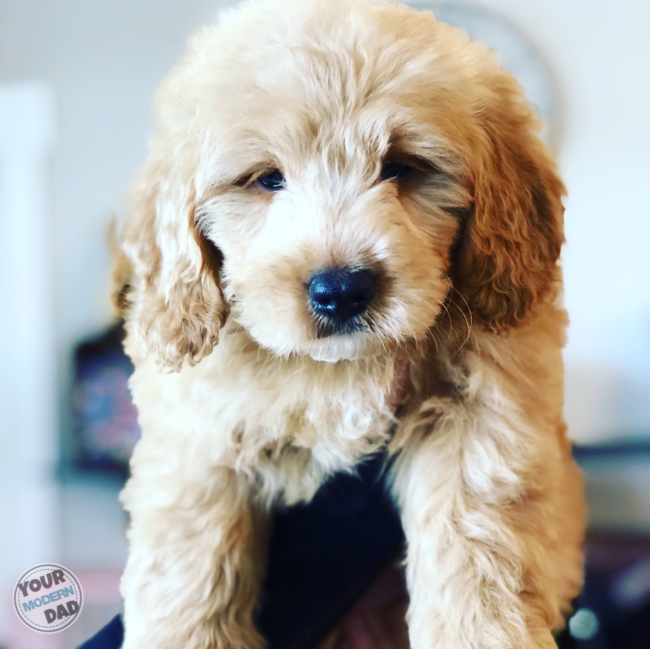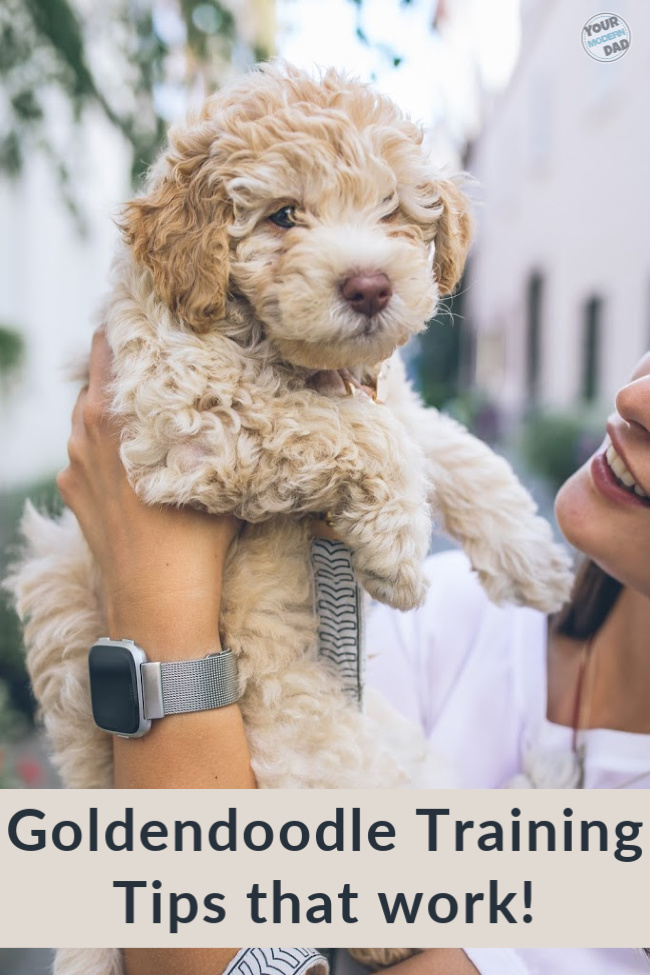What does a family of four kids, one dog, and one cat need? Apparently… a puppy! Introducing Chance, our mini Goldendoodle puppy. Today we are talking about Goldendoodle Training.

Chance is the most gentle puppy. He learned quickly from our four-year-old Standard Goldendoodle (and now Chance’s best friend) how to act & behave in our house and around our four children.
Our dogs took to each other very quickly, and we’re grateful that Coach (the older dog) has been such an amazing & patient leader, teacher, and big brother.

However… at four months of age, Chance (our mini Goldendoodle puppy) still needs to learn a few things, so it works out that 4 months is a great time to start training a puppy.
When is the best age to train a mini Goldendoodle puppy (or any puppy?)
“Young puppies have short attention spans, but you can expect them to begin to learn simple obedience commands such as “sit,” “down,” and “stay” as young as seven to eight weeks of age.
“Formal dog training has traditionally been delayed until six months of age,” according to the Veterinary Centers of America. It is best to begin your Goldendoodle Training around the same time.
How do dog trainers train puppies?
When we adopted Coach years ago, we worked with a dog trainer. He met us for private lessons each week for eight weeks to show us exactly what we needed to do, and it worked wonders! Coach is such a great dog.
Training Goodledoodles at Home vs. a Facility
When it comes to Goldendoodle training, I highly suggest getting a trainer that can work with you on a weekly basis for a few months. It makes a world of difference in the life of your dog.
We opted to train our dog at home because we wanted to be the one that he was used to learning from daily. Our trainer worked with us, and we, in turn, worked with our dog.
We’ve heard of dog training where they take your dog for several weeks and bring them back trained, but we knew that our family would have missed him too much, so we didn’t want to do that sort of training.
Dog training schools & trainers typically offer several dog training methods, such as teaching you to use clicker training and training with food rewards, praise, or play/toy rewards.
Today I’ve spoken with two trainers, one veterinarian, and a dog breeder to bring you information on dog training so you can find the best one for your dog.
Dog Training Theory: Positive Reinforcement
A vast majority of certified dog trainers subscribe to training methods that utilize positive reinforcement. My wife would only choose this method if she were a trainer.
The major theory behind positive reinforcement is this: Rewarding good behavior makes that behavior more likely to occur in the future.
In conjunction, many trainers will also provide negative feedback to interrupt behavior is incorrect; this negative feedback typically consists of a sharp sound like “tssst” or another benign attention-getter, such as a spray from a water bottle.
Once the dog’s attention is diverted from the inappropriate action, the dog can be redirected into performing a positive behavior, which is then rewarded.
The following four dog obedience training methods utilize positive reinforcement and association.
- Clicker training
- Rewards of food
- Rewards of praise/attention
- Rewards of toys/play.
Each dog’s temperament and preferences are different, which means the most effective method will vary from dog to dog; a certified dog trainer can assist dog owners in determining which approach will be most effective for training a dog.
In fact, good dog training schools will conduct interviews before starting obedience training to develop a training plan with the pet owner. You will soon find that when it comes to Goldendoodle Training – it is as much about your dog & its personality as it is about you & your consistency.
1. Dog Obedience Training Method: Clicker Training
When it comes to obedience training, clicker training is a very popular dog training technique among certified dog trainers. Clicker training for dogs involves the use of a hand-held device that creates a clicking sound.
When the dog is given a reward as reinforcement for “sitting,” “staying,” or another obedience command, the treat, toy, or praise reward is paired with the clicking sound.
Over time, the dog begins to associate the clicking sound with the reward. Once the dog is reliable in his obedience skills, the food rewards are given only occasionally, but the clicking continues on a consistent basis, serving as an indicator of praise for the dog.
If you need a clicker, you can find them at a pet store or on Amazon. Here is a quick affiliate link to find the ones that we have: DOG CLICKER
2. Obedience Training Technique: Food Rewards
When it comes to training Goldendoodle puppies, it’s about finding out what is going to motivate your dog. Goldendoodle training is similar to training most puppies since they are a mix between a golden retriever and a poodle, which means that rewarding with treats usually works well.
Many dogs have a very high food drive. Food rewards can work well for a dog obedience training reward in these dogs.
A food reward can consist of a traditional dog treat or other less traditional pet treat foods like baby carrots, pieces of cheese, cold cuts, hot dog bits, or other high-value foods.
The key to eliciting certain behaviors from a dog in a dog training course setting is to maintain the dog’s attention, and food can help owners achieve this. The food also serves as an effective, high-value reward for the dog. Our trainer & our vet suggested small bites of a hotdog as a high-value treat.

3. Obedience Training Methods for Dogs: Toy Rewards
Dogs who have a high prey drive – like sighthounds such as the greyhound breed, will often place a higher value on toy rewards like a ball. Or use my affiliate link to find this dog toy that we have (it has 11,000 5-star reviews on Amazon!
Toy rewards are good for the dog that would be apt to pick the toy when presented with an option between a treat and a toy.
Certified dog trainers who are working with clients who undergo frequent dog training courses, such as a police dog or a cadaver dog, will typically opt to use toy and play rewards since toys can be used for specialized dog training.
In the case of a drug detection dog or cadaver dog, the dog’s toy will be scented with a synthetic scent that mimics the scent of drugs or decomposition. In essence, the working dog learns to detect drugs by seeking his toy during retrieval exercises.
4. Obedience Training Using Praise as a Reward
This approach is good when training a very people-oriented dog and in tune with his humans. When we want to reward good dog behavior, especially when house training, we use praise with food rewards.
Often, praise is used in conjunction with toy rewards, clicker training, or food rewards. Occasionally, a dog trainer may use praise and attention alone to teach certain obedience training commands.
Praise is often used as a training reward for dogs who have suffered abuse or neglect, as praise helps develop a dog’s self-confidence and trust in humans. Although, on the flip side, we have used it for our dogs (not abused), and they have responded very well to it. Praise works for adult dogs and puppies.
What about Crate Training?
Crate training is another Goldendoodle Training method used to teach your dog or to get your dogs on a routine. It teaches your puppy that they do not go to the bathroom where you sleep since dogs do not like to soil their beds. This will also get your dog on a great schedule, so you can use the non-crate time to eat, take a walk, go outside for a bathroom break, play, learn basic commands, and snuggle.
The time in the crate is for sleeping and resting. It will become their safe place and a place that they enjoy.
Do not use a crate for punishment. Your goal is to make it a safe place where they like to be.
All in all, pick one thing and be consistent. Consistency is the key to success… and you’ll have a happy, well-behaved dog!
More Puppy Training Articles:
– Is your puppy chewing furniture? Try this!
– Is your dog begging for food while you eat? This works.
Puppies chew because they are either teething or bored. Puppies will lose their baby teeth in the first 3-4 months, they will need thing they are allowed to chew on. Give them things that are safe to chew on.
Thanks for the blog post on Goldendoodle puppy training! I remember when I had my own Goldendoodle, Sparky, and how I struggled with his training, especially crate training. Thankfully, I came across these tips and saw great improvements in Sparky’s behavior – it was as if he had transformed into a different pup! The key was consistency, just like Mickey mentioned, and I couldn’t be happier with the results.